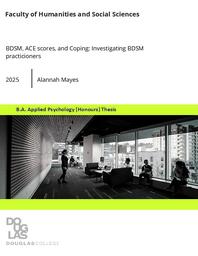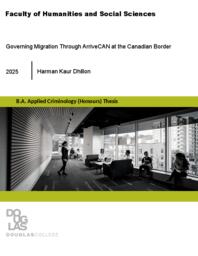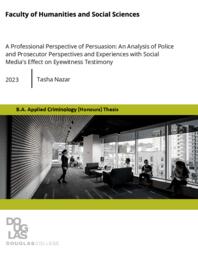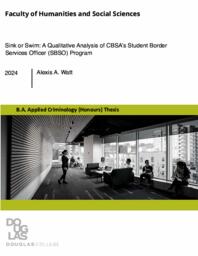Criminology
Related Works
Content type
Digital Document
Abstract
This study is interested in understanding the relationship between BDSM and emotional approach coping skills. This is under a theoretical assumption that there are positive benefits to being a regular practitioner of BDSM. Some stereotypes of people who practice BDSM involve a pathological or traumatized narrative. To test this assumption ACE scores were also measured along with both positive and negative coping skills. This research hopes to provide more clarity to the growing knowledge of positive sexuality as a healing tool.
Origin Information
Content type
Digital Document
Description / Synopsis
This study sought to examine the construction of the ArriveCAN app that was used during COVID-19, and added to the interdisciplinary and criminological literature relating to the digitization of the border in relation to these constructions and uses of the ArriveCAN app.
Origin Information
Content type
Digital Document
Abstract
Canada’s correctional institutions are largely private and hidden from public view; because of this, much of the public gets their information regarding the criminal justice system from popular media. As it stands, there is a lack of research regarding the portrayal of correctional guards in popular media. A large portion of research pertaining to correctional guards is focused on how guards are portrayed in news media rather than popular media. The existing research into correctional guards in news presents them in a negative light with a tendency to focus on non-prisoner harassment, crime unrelated to the job, and budgetary issues (Vickovic et al., 2013). This thesis presents the result of qualitative exploratory study using content analysis as a means of understanding how correctional guards are portrayed in popular media. Ten of the top thirty grossing prison films released between 1994 and 2024 were analyzed thematically using grounded theory methods. The results show that correctional guards are generally portrayed as violent, aggressive, lazy, and lack respect for the prisoners. The significance of this study not only includes adding to popular criminology research but also offering a potential explanation for some motivations of becoming a correctional guard and explaining the gendered aspects of the ways in which correctional guards are portrayed and implications that may have on prisoners.
Future implications of this study include contributing to the literature surrounding prisoning, correctional guards, and popular criminology and transforming people’s views and perceptions regarding correctional guards by pointing out protentional inaccuracies.
Origin Information
Content type
Digital Document
Abstract
This study explores the complex relationship between alcohol use and occupational identity among musicians working within nightlife venues in Vancouver, British Columbia. While prior research has examined alcohol consumption in the hospitality sector, little attention has been paid to musicians as a distinct labor group operating within similarly permissive and criminogenic environments. Drawing on semi-structured interviews with active musicians, this research investigates how alcohol functions within the music industry, as a social lubricant, coping mechanism, reputational tool, and workplace expectation. The study applies Erving Goffman’s (1959) dramaturgical model to understand how musicians perform identity in alcohol-saturated spaces, and Sampson and Laub’s (1993) life course theory to examine patterns of desistance over time. Findings reveal that alcohol use is deeply embedded in the professional and cultural expectations surrounding live performance, with drinking often seen as integral to networking, performance energy, and audience engagement. However, many participants also expressed increasing awareness of the long-term personal and professional consequences of sustained alcohol use, leading some to reject or renegotiate their relationship with alcohol. By situating musicians within broader criminological frameworks, this study contributes to a deeper understanding of how occupational contexts shape behavior and identity in high-risk cultural industries
Origin Information
Content type
Digital Document
Abstract
Every day, people across the country log onto Twitter, Facebook, Instagram, and other forms of public communication to get the latest information on significant events happening in their communities. One of the more newsworthy categories is often crime stories. For those who have witnessed a crime, turning to social media can become a form of influence that can affect their statement to the police and in court. This study takes a qualitative approach to examine themes consistent with social media’s influence on eyewitness testimony. The project accomplished this by conducting six in-depth interviews with three police officers and three prosecutors. All the police officers were employed in the RCMP Major Crimes division, with two being part of the interview team at one point in their careers. Two prosecutors worked as trial crown council members for the BC Prosecution Service for most of their law careers. The last decided to keep their affiliations confidential. Five themes were discovered during the study. These themes included social media’s status as neither good nor bad, eyewitnesses’ decreasing importance in court, social media’s impact on how participants talk with witnesses, the case-by-case nature of everything in the justice system and the differing definitions of social media.
Origin Information
Content type
Digital Document
Abstract
Each summer, hundreds of Canadian post-secondary students are recruited by Canada Border Services Agency (CBSA) under the Federal Student Work Experience Program (FSWEP) to become Student Border Services Officers (SBSOs). In a paid, non-union role, students act in similar capacities to full-time Border Services Officer (BSO) labour. This thesis provides an in-depth analysis of the never before examined SBSO program in an academic context. Through qualitative interviews conducted with former SBSOs, a wide range of issues were uncovered, from low wages to poor culture, in addition to the challenges and tribulations associated with the examination of insular organizations, such as CBSA.
Origin Information
Content type
Digital Document
Abstract
This article combines findings concerning institutional discourses with knowledge of frontline officials and non-officials gleaned from qualitative interviews with border services officers (BSOs) and travelers living and working in the Windsor, Ontario, Canada borderland to discuss the technologization of modern Canadian borders. Findings generated from interview data reveal that both frontline officials and non-officials experience a border where the personal narrative and performativity of the embodied subject traveler is increasingly irrelevant, with officer decision-making supplanted by information contained in databases. Findings also explore various dangers associated with increased simulation and cyborg work, including database errors having demonstrable consequences on the mobility and rights of human beings; the colonization of the lifeworld of BSOs by digitized risk technologies ultimately rendering officers incapable of asking questions, looking for indicators, and making informed decisions on the basis of anything other than databases; and the associated human rights, privacy, and legal implications that are potentially wide-ranging and extremely troubling.
Origin Information
Content type
Digital Document
Abstract
In this paper, we shed light on the question of whether it is morally permissible to enslave artificially intelligent entities by looking at up to date research from the social sciences – as well as the ancient lessons from Jewish law. The first part of the article looks at general ethical questions surrounding the ethics of AI and slavery by looking at contemporary social science research and the moral status of ‘Sex Bots’ – AI entities that are built for the purpose of satisfying human sexual desires. The second part presents a Jewish perspective on the obligation to protect artificial intelligent entities from abuse and raises the issue of the use of such entities in the context of sex therapy. This is followed by a review of slavery and in particular, female slavery in Jewish law and ethics. In the conclusions, we argue that both perspectives provide justification for the ‘Tragedy of the Master’ – that in enslaving AI we risk doing great harm to ourselves. This has significant and negative consequences for us – as individuals, in our relationships, and as a society that strives to value the dignity, autonomy, and moral worth of all sentient beings.
Origin Information
Content type
Digital Document
Abstract
Offenders and crime, especially those with a violent nature, are rife within the news media. However, little research exists pertaining to these offenders who are going to be, or nearing, their release on parole. This thesis aimed to extend prior literature by conducting two qualitative content analyses. The first included a general selection of Canadian parole-based newspaper articles from 2002 to 2022 in order to create a foundation of how parole is represented in the media. The second was an in-depth analysis that drew upon articles from a male offender (Larry Takahashi) and a female offender (Joanna Larson) to compare representations based on gender. This exploration uncovered four central themes, the types of crimes published, gender of offenders, age of victims, and the usage of certain language. The results of this study revealed several implications related to community attitudes, and public policy.
Origin Information
Content type
Digital Document
Origin Information










